Chapter 5: LEGO Storage for Large Collections
Considerations for large collections
There are several different ways to store a large collection of LEGO bricks. They range from high-end solutions with a drawer or compartment for each part, to inexpensive ziploc bags stored in larger drawers or bins.
Storage solutions for large collections
There is no “perfect” storage solution because everyone’s budget, storage location, and building style is different. Each of these products will appeal to different people.
- You may choose to use one product for some pieces (such as basic bricks) and another product for everything else (such as rare or seldom-used pieces).
Drawer Cabinets
One of the most popular storage solutions among AFOL’s with large collections are Plastic Drawer Cabinets. They are reasonably priced, and with more than 50 drawers per cabinet you can sort your pieces by Part, or even by Element (Part + Color).
Selection and quality varies greatly, with only one or two brands receiving the majority of attention in a given region. In the United States, Akro-Mils is the most popular brand due to their high quality and fair price, but other brands like Iris and Stack-on (now discontinued) are also popular.
Features to look for in these cabinets include:
- Durable drawers (which bend instead of breaking).
- Drawers that can be removed easily.
- Drawers that can be stacked when they are removed from the cabinet.
- Drawers that are the right size for your needs.
- Cabinets that can be stacked on a desk or table.
- Cabinets that can be wall-mounted.
Recommended Products
Plastic drawer cabinets by Akro-Mils are the top pick for most LEGO enthusiasts in the USA. They have several advantages over other options including: drawers are easily removed and stack-able, drawers are deep enough for 16-stud bricks, drawers are flexible which makes them hard to break, and have competitive prices.
The drawers have interior measurements of 5.0 × 13.3 × 3.7 cm h (2 × 5¼ × 1½″ h), and a volume of 0.25 liters (15¼ in³).
In addition to the 64-drawer cabinet, Akro-Mils offers cabinets with larger drawers. The 24-drawer cabinet contains only large drawers, and the 44-drawer cabinet includes a mix of small and large drawers.
The larger drawers have interior measurements of 10.8 × 13.3 × 5.3 cm h (4¼ × 5¼ × 2″ h), and a volume of 0.76 liters (46⅓ in³).
Drawers with dividers
If you want to store your LEGO collection like the LEGO design studios in Billund, you want large drawers with divided compartments. Drawers with dividers allow you to keep a large collection meticulously organized, and they take up less wall space than the drawer cabinets highlighted above. These cabinets are especially well suited for people who want to separate pieces by Element (Part + Color) instead of just by Part.
I’ve seen beautiful examples of drawers with every common brick and plate of a single color in one cabinet, or alternately, every color of a single part in a single drawer. Which organizational scheme you pick will depend on whether you think about the LEGO library of elements by color first, or by part first.
Recommended Products
This UK company makes the only storage drawers designed specifically for LEGO Bricks. The dividers are removeable, and each compartment is slightly larger than 8×8 studs.
Drawers can be configured with up to 15 compartments measuring about 7 × 7.5 × 6 cm h (2¾ × 3 × 2⅓″ h), with a volume of 0.32 liters (19 1/4 in³).
Really Useful Products makes high quality drawers designed for scrapbooking, and an optional divided insert with 15 compartments that works great for large LEGO collections. These are really large drawers that can hold a lot of LEGO bricks.
With the insert, each of the 15 divided compartments are 10.5 × 7.0 × 7.5 cm h (4⅛ × 2¾ × 2⅞″ h), with a volume of 0.55 liters (33.6 in³).
Each compartment in the Really Useful drawers is about 70% larger than the Papimax Drawers. Because each compartment is so large, the Really Useful Drawers are most appealing for extremely large collections and large LEGO rooms.
Note: Both of these options are now available in the US. They are fairly expensive specialty products, and can only be purchased direct from the manufacturers.
Removable Compartment Organizers
One of the newest products to gain popularity with LEGO builders is a new kind of tackle box with removable compartments. Many LEGO builders like how these have tight-fitting lids, but you can remove just one compartment and bring it to your build area.
These products typically come in both a regular, and deep option. The shallower options are better for people who want a lot of small storage containers, especially when sorting by Part or by Element (both Part and Color). You typically get more compartments this way, and they aren’t as deep so it’s easier to remove parts from the bottom of each compartment. The deeper options only make sense if you sort by both part and color, and have a lot of basic bricks that you need to store.
Recommended Products
With 25 removeable compartments, this is a great option for collections which are very well organized. A tight-fitting lid makes this perfect for portable LEGO Collections.
They also offer a deeper version of this product with just 10 larger compartments.
Stanley also offers a more expensive FatMax option which is probably overkill for LEGO storage.
It is also sold under the Dewalt brand, which might be cheaper.
Tackle Boxes
Tackle boxes are popular in the crafting community, and they are popular with LEGO enthusiasts as well. These containers have divided compartments and a tight fitting lid, and are less expensive than some other options. The most common designs have a lid which is attached to the base with a hinge, and the size of each compartment is often adjustable with plastic dividers.
Accessing a specific part is a bit slower than some other solutions, as you need to find the right container, fold it open, and carefully remove the parts you need without causing an earthquake (where parts end up shifting into the wrong compartment.) That said, they are extremely portable, making them a great choice for younger builders, or people who need to bring parts to a LEGO convention. It’s also a good deep storage option for well-organized builders who need an inexpensive and efficient storage solution for less frequently used parts.
- Plano Tackle Boxes – Tackle boxes come in a wide range of sizes, but the larger sizes can hold more LEGO bricks. I recommend the 3700 Series which is 14 × 9¼ × 2″ tall, and has up to 24 compartments. The smaller 3600 Series is 11 × 7¼ × 1¾″ tall, with up to 21 compartments. (Anything smaller than this is probably too small for LEGO bricks.)
- Plano Multi-tray Tackle Box – For the ultimate in well-organized portable storage, consider one of these large tackle boxes which store up to four tackle box trays. The Plano 1374 Rack System holds four of the 3700 Series Tackle Boxes recommended above.
Plastic Bags
Plastic bags are one of the cheapest and most commonly used LEGO storage containers. It helps that they are very easy to find — you can buy them at almost any grocery store. That said, not all bags are created equal… Premium bags don’t cost much more, but they include convenient Sliding zippers, and are designed to stand up when placed on the ground. This might not seem like a big deal, but it’s really helpful since you can leave a bag unzipped without worrying about it falling over and spilling pieces all over your workspace.
Plastic Bags are especially well suited as overflow storage for people with very large collections — you can stack a lot of bags in a box or large drawer without wasting space. (Plastic Bags are also useful for storing sets, manuals, or other LEGO accessories.)
I strongly recommend having bags available in all sizes: from small 3 × 5″ bags to very large 2.5 Gallon bags — They are inexpensive, and you never know when you will need them!
- Ziploc Slider Stand & Fill Bags – This is the premium option for storing LEGO bricks in bags. The slider makes it easier to open and close, and the bag stands up while you fill it. Available in Quart, Gallon, or a Variety packs. (For even larger quantities, or to store a complete LEGO set, try the Hefty Slider 2.5 Gallon Bag.)
- Standard Plastic bags – The most common sizes are Sandwich, Quart, and Gallon. The name brand regular bags cost almost as much as the Slider bags, but you might be able to find inexpensive generic bags at your grocery store. The “Freezer” bags are thicker and more durable, but more expensive. (I really like the Snack Size, which is the same width as the Sandwich size, but half as tall. It’s perfect for small parts and accessories.)
- Small Bags – If you’ve ever purchased LEGO bricks on Bricklink, you probably received some of them in very small plastic bags. The smallest size I can recommend are the 3 × 5″ bags, which are cheap and can hold a fair number of pieces. (The 2 × 3″ bags aren’t very useful, although they are large enough to store a couple bricks or a single LEGO Minifigure.)
Open-front Bins
While they are designed for industrial applications, some professional LEGO builders use open-front storage for common bricks. This storage solution takes up a lot of space, so it only makes sense if you have a very large quantity of common elements.
The main concern with this storage solution is that it is expensive, takes up a lot of space, and pieces can fall out if the container is too full.

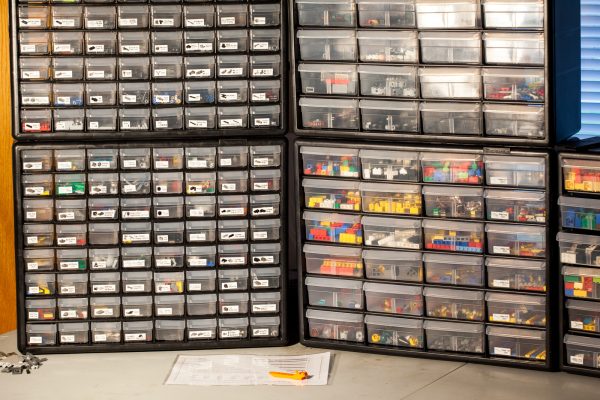


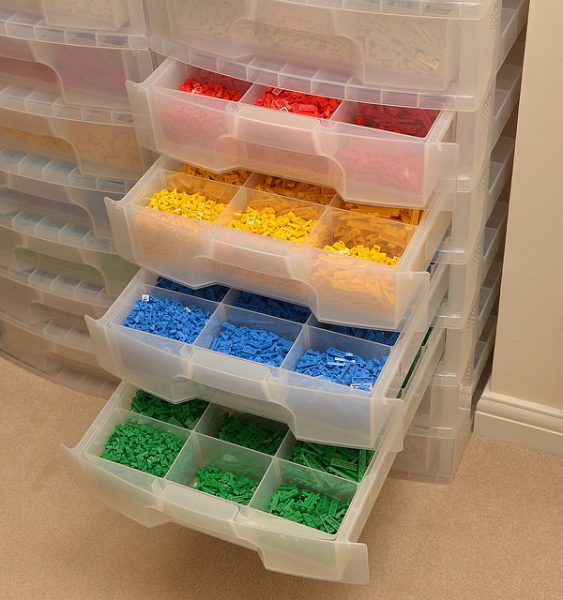
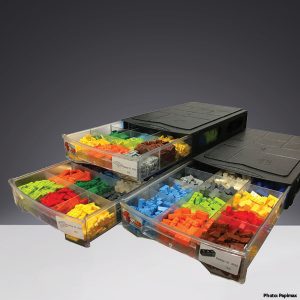


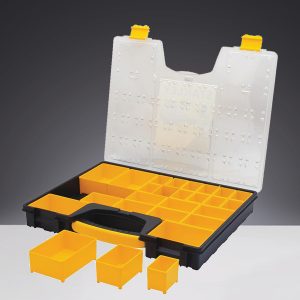
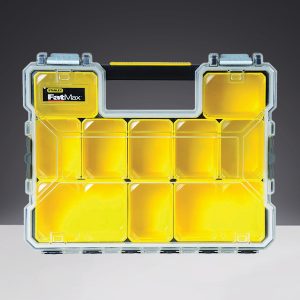
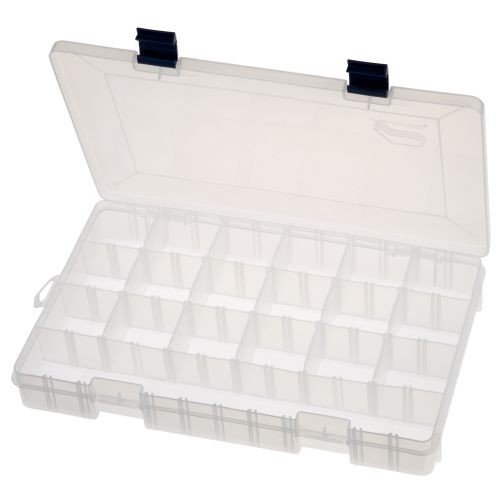

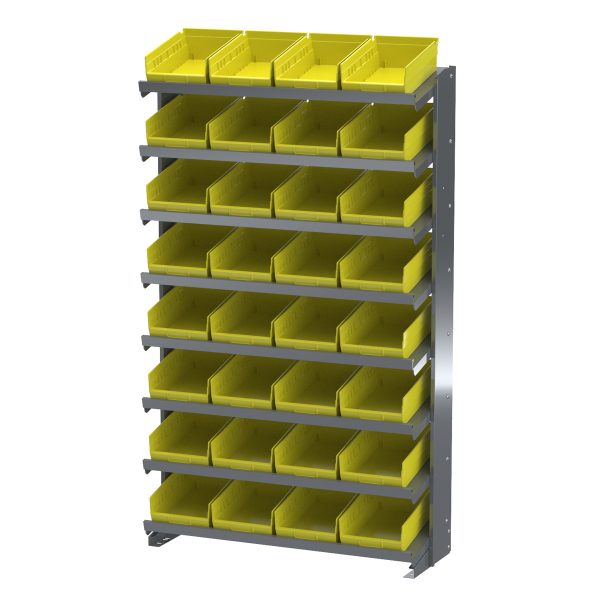
Thank you for your helpful insights. I have a large enough collection that requires me to organize the pieces by parts and sometimes also by colors. And my 7-year-olds and 5-year-old are already comfortable with finding the right pieces themselves. I’d like to hear your thoughts about organizing the very small pieces, including mini-fig accessories and decorative pieces. Not only they are small, there are a wide variety of them, but just very few pieces each. I have one tackle box for now, but the small pieces sometimes get stuck under the dividers. Accidents do happen and pieces get mixed up quickly. How about one of those small acrylic jewelry organizer boxes that have like 120 compartments? Have anyone use those for small parts?
The very small jewelery organizers might work, but I do find it difficult to get small parts outside of the tiny compartments. I’m curious to hear your thoughts if you do give it a try.
In the USA, Harbor Freight, 4 in. Stacking Tilt Bin. They can connect on all 4 sides and have mounting holes in the back. Currently listed for $2.99 but are often on sale for half or more off. HF also has knock off Stanley organizers for $10 (shallow) and $14 (deep). The quality is not Stanley but for LEGO storage they will do just fine.
Thanks for the awesome work you do–this guide is fantastic. My six-year-old is LEGO obsessed and, along with sets, we’ve bought and been given many bulk lots. We’re currently using these Sterilite stackable drawers with homemade dividers (https://www.amazon.com/dp/B002BA5F2A?psc=1&ref=ppx_yo2ov_dt_b_product_details), plus HART brand locking cases that have tubs in them for small, specialized pieces. So far, that’s worked well for categorizing by type, and we’re expanding enough to categorize by color as well. I’ll look into the Akro Mills cabinets for the small pieces, because the HART cases take up a lot of room when we have the lids open.
I use removable compartment containers in old card file cabinets. I probably have 10 cabinets worth. The containers let you upgrade and downgrade size based on quantities.
The containers are cheapest at harbor freight. If you wait till a 30% off sale the price is quite reasonable.
Hi Tom.
I was wondering based on the pdf preview, you have all 1x bricks in one group. Does that mean that you would put all of them into one bin? I have roughly 15-20K pieces. They are almost exclusively from sets and I only build buildings and landscape settings. I currently have all my pieces mostly broken down by part.
Thanks 🙂
Which categories to use depends greatly on the size of your collection and what you like to build.
I personally recommend sorting basic parts by size (1×1, 1×2, etc…) unless you have a pretty small collection. This does result in a lot of containers, which can be costly and take up a lot of space. For my son’s smaller collection, I have one bin for bricks, and one for plates. That is enough granularity for smaller collections.
—tom
For Plano boxes, use a wire rack system to stack them vertically. They work like drawers! “Organised Fishing” and “Old Cedar” are two brands. The search words “modular utility box wire racks” will find them for you. They have been hard to get since Covid 19. Maybe they will make a comeback. They come in capacities of 4, 6, 8, and 14. The 4, 6, and 8 capacity ones are stackable. 5 racks with 60 boxes will fit on a 6 foot building table, very handy. Under the table, “Iris”drawer units on wheels will roll out to the sides for even more accessability. Pictures available.
This is very interesting and I plan to look into it for my own collection and future updates to this guide. I love the Akro-mils style drawers for common parts, but Tackle Boxes can be very cheap and work really well for less-used parts like Minifig accessories.
Thanks for the suggestion!
Do you have a plan to update this guide soon?
I update the guide periodically, but I will admit that the entire guide is due for a thorough review and some updates. When I do update it, I will focus on highlighting new storage products, as well as additional strategies which I have learned in the past couple years.
Thank you! I really appreciate it!! Do you think you will be doing this thorough review sometime in the next couple months by chance? 🙂
Can you please post pictures and link which tackle boxes you are using?
What do you recommend as long-term Lego storage (many large and small built sets) and several large bins of miscellaneous (disassembled sets from when kids were young) that teen sons have moved on from? We have bedroom closets shelf for space. Do you recommend tearing down the sets and storing in a 3-gallon zip lock bag, etc. These Legos will be stored for the next generation in our family. Thank you for your guidance.
It is hard to beat large ziploc bags stored in standard (Stackable) cardboard boxes. As you noted, the 3+ gallon bags are great for larger sets. You can fill the bag up with the parts and squeeze out the air to store a ton of sets in a small amount of space. (Don’t forget a label, unless you decide to store the instructions in the bag too)
Happy sorting and safekeeping!
—Tom
Check out rotary cutting mats, available at fabric stores, JoAnn, Michaels, Hobby Lobby. They come in green, grey, and translucent white. I love mine
How do you personally sort your larger plates such as semi circles, wings, angles, large squares, 6x12s, etc? They don’t fit well in Akro Mills containers. I had originally loosely stacked them together to save space, but that option failed me spectacularly (yay being young with arthritic hands).
I store them in plastic bags and put the bags into a much larger (inexpensive) sterilite drawer. That’s where very big parts go, as well as overflow storage beyond what fits in an Akro-mils drawer. (Most of my overflow parts are those I purchased in bulk through LUGBULK program.)
—tom
Thank you for your hard work. I’m only starting out in Lego for me and my grandson – your work has been incredibly helpful. From the labels, to you book, to this guide. It is very, very much appreciated.
Really great site and article. I’m getting ready to sort through a 10,000+ piece collection and this was very helpful. Thank you
This is amazing with great suggestions. Curious if you have gathered info from anyone building over carpet? Maybe temp flooring or other under table suggestions for catching dropped tiny pieces so they don’t get lost in medium pile carpet? We don’t have the option to remove or replace unfortunately and have two boys with an 18,000 strong collection we are trying to make more accessible and fun.
If I were building a LEGO room from scratch, I would definitely choose Laminate or Hardwood, but normal-length carpet isn’t too bad. I would probably save your money and live with the occasional inconvenience… (or spend it on more LEGO?)
—tom
I may have missed it in my scanning, but do you have recommendations for base plate storage to prevent dust as well as bending?
I don’t think it is mentioned, but larger drawers like Sterilite or the Really Useful Boxes Scrapbook drawers are perfect for this. You could also use a hanging file cabinet if you already have one for storing instruction manuals.
Standard file cabinet. Tip them upright. Use the stopper to keep them upright. I sorted by type.
Hi! Thanks for the very detailed book. I have a medium but growing collection and have been using drawer cabinets so far which is great as you say to easily find pieces, move around etc. But what about the dust? You mention the dust when talking about the open bins but my lego are getting dusty in the akro-mills drawer cabinets equivalent I have. So started to consider moving to closed boxes but I’m concerned about losing on accessibility. Any drawer cabinets that have lids in your experience?
I have not had a problem with dust when using the Akro-mils bins, but my LEGO room has hardwood floors and an air filter. You are right to point out that the small gap above each drawer could be enough to cause problem in dustier environments!
—Tom
Hi Tom,
This is so helpful! Thank you.
My 5 1/2 year old son was given a massive, jumbled collection of legos about 30K pieces by my estimation after sorting by color and volume. A wonderful group of Star Wars and Harry Potter that he will definitely grow into!
For now I sorted them by color into clear plastic shoe boxes that I had around the house. I have 13 small shoe boxes (11″ l x 7″w x 4″ h), 1 medium (13″l x 9″w x 6″h), 1 large (20″ l x 13″w x 6″h). Some are really full, others less so. He is clearly not ready to maintain a highly organized and large collection, but I want to set us up for success down the line. I was thinking of getting the really useful boxes to organize and store what ever he is not using currently on his lego table. How many do you think I need? Would you recommend getting one drawer per color? Thank you in advance!
I would recommend about 8 drawers, and personally prefer the clear drawers to the rainbow colored drawers because you can more easily see what’s inside.
As for sorting strategies, I would recommend sorting into broad categories like “Bricks, Plates, Angle Pieces, Round Pieces, Minifigures and Animals, Accessories/Other” – That’s the strategy I’m using with my toddler’s Duplo collection, and we found that he learned the categories pretty easily. Justhelp him sort a few times and he should pick up the top level categories. Labels on the drawers will help too!
Sincerely,
—Tom
P.S. The previous chapter, Chapter 4: LEGO Storage for Medium Collections is better aligned with the size of your collection.
I have a somewhat related question. My son 21 has a fairly large collection of lego. He wants to know if you have a recommendation for a building surface. He says his desk is slippery but doesn’t want to use base plates. Do you have any recommendations for a non slip smooth surface. Thanks.
I have never had a problem with the building surface being too slippery; a wooden table has worked well for me and prevents the model from slipping too easily.
If someone has limited dexterity or a limb difference, a large silicone mat might help prevent parts from moving when building. I haven’t tried this, but I bet it would help!
—Tom
I’ve been using a padded microfiber bath mat. It’s non-slip, it gives a comfortable place to rest one’s hands, and the little give of the padding makes scooping /shoving/sorting large numbers of parts very easy.
In our house, for our sorted pieces, we primarily use the Stanley-style removeable compartment organizers. There are cheaper versions available at Northern Tool or Harbor Freight, we have a combination of these. Stanley/Dewalt are definitely of a higher quality. We also use 6 qt clear latch storage bins (https://smile.amazon.com/gp/product/B01DDGDT64/ref=ppx_yo_dt_b_search_asin_title?ie=UTF8&psc=1) fir more numerous and larger pieces IE large plates, standard bricks, windows and cockpit clear pieces
We use restaurant bus tubs with lids for unsorted pieces and partially (dis)assembled builds. My son (age 7) is the primary builder. The bus tubs allow for/inspire creativity, while the compartment organizers make it possible for me to quickly find a specific piece he may need for a build.
Good Morning Tom about the totally useful boxes do you have a tip on how to order the dividers
I think you can order direct from Really Useful Boxes company.
ex: https://www.reallyusefulproducts.co.uk/usa/
Just a heads up, Papimax no longer has a US listing. You still may be able to order from them on their UK site.
They ran into manufacturing difficulties during 2020 (sounds like it was a combo of Covid-19 and other factors) and temporarily suspended production. They insist they’ll be available again sometime in 2021. We shall see.
Hi Tom, awesome article and I really appreciate it! How many of the small drawers (approximately) would you recommend for a collection of approx 30,000 pieces?
It really depends on how diverse your collection is, but I would guess that between 8 and 12 akro-mils cabinets containing 64 drawers each would be sufficient. (ex: If you only have Technic, you might need a lot fewer cabinets, and if you don’t have any Technic at all, you might only need slightly fewer cabinets.)
Remember, you can always put multiple similar parts in the same drawer, or have a “other” drawer for parts that you only have one or two of!